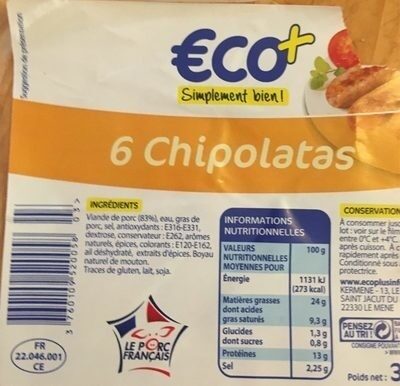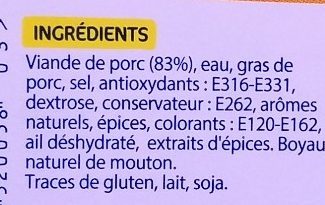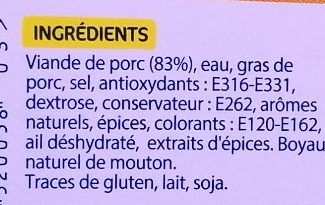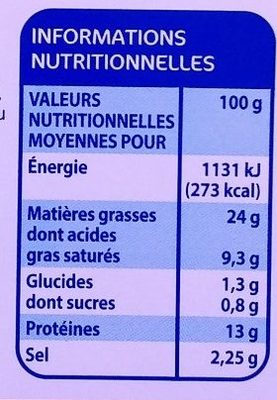Help us make food transparency the norm!
As a non-profit organization, we depend on your donations to continue informing consumers around the world about what they eat.
The food revolution starts with you!
6 chipolatas - Eco+ - 330 g
6 chipolatas - Eco+ - 330 g
This product page is not complete. You can help to complete it by editing it and adding more data from the photos we have, or by taking more photos using the app for Android or iPhone/iPad. Thank you!
×
Barcode: 3760109520058 (EAN / EAN-13)
Quantity: 330 g
Brands: Eco+
Categories: Meats and their products, Meats, Prepared meats, Sausages, French sausages, Chipolatas
Labels, certifications, awards:
French meat, French pork, Green Dot
Origin of ingredients: France
Manufacturing or processing places: France
Traceability code: FR 22.046.001 CE - Collinée (Côtes-d'Armor, France)
Stores: Leclerc
Countries where sold: France
Matching with your preferences
Health
Ingredients
-
18 ingredients
: Viande de porc (83%), eau, gras de porc, sel, antioxydants : E316-E331, dextrose, conservateur : E262, arômes naturels, épices, colorants : E120-E162, ail déshydraté, extraits d'épices. Boyau naturel de mouton.Traces: Gluten, Milk, Soybeans
Food processing
-
Ultra processed foods
Elements that indicate the product is in the 4 - Ultra processed food and drink products group:
- Additive: E120 - Cochineal
- Additive: E162 - Beetroot red
- Ingredient: Colour
- Ingredient: Dextrose
- Ingredient: Flavouring
- Ingredient: Glucose
Food products are classified into 4 groups according to their degree of processing:
- Unprocessed or minimally processed foods
- Processed culinary ingredients
- Processed foods
- Ultra processed foods
The determination of the group is based on the category of the product and on the ingredients it contains.
Additives
-
E120 - Cochineal
Carminic acid: Carminic acid -C22H20O13- is a red glucosidal hydroxyanthrapurin that occurs naturally in some scale insects, such as the cochineal, Armenian cochineal, and Polish cochineal. The insects produce the acid as a deterrent to predators. An aluminum salt of carminic acid is the coloring agent in carmine. Synonyms are C.I. 75470 and C.I. Natural Red 4. The chemical structure of carminic acid consists of a core anthraquinone structure linked to a glucose sugar unit. Carminic acid was first synthesized in the laboratory by organic chemists in 1991.Source: Wikipedia
-
E162 - Beetroot red
Betanin: Betanin, or Beetroot Red, is a red glycosidic food dye obtained from beets; its aglycone, obtained by hydrolyzing away the glucose molecule, is betanidin. As a food additive, its E number is E162. The color of betanin depends on pH; between four and five it is bright bluish-red, becoming blue-violet as the pH increases. Once the pH reaches alkaline levels betanin degrades by hydrolysis, resulting in a yellow-brown color. Betanin is a betalain pigment, together with isobetanin, probetanin, and neobetanin. Other pigments contained in beet are indicaxanthin and vulgaxanthins.Source: Wikipedia
-
E262 - Sodium acetates
Sodium acetate: Sodium acetate, CH3COONa, also abbreviated NaOAc, is the sodium salt of acetic acid. This colorless deliquescent salt has a wide range of uses.Source: Wikipedia
-
E316 - Sodium erythorbate
Sodium erythorbate: Sodium erythorbate -C6H7NaO6- is a food additive used predominantly in meats, poultry, and soft drinks. Chemically, it is the sodium salt of erythorbic acid. When used in processed meat such as hot dogs and beef sticks, it increases the rate at which nitrite reduces to nitric oxide, thus facilitating a faster cure and retaining the pink coloring. As an antioxidant structurally related to vitamin C, it helps improve flavor stability and prevents the formation of carcinogenic nitrosamines. When used as a food additive, its E number is E316. The use of erythorbic acid and sodium erythorbate as a food preservative has increased greatly since the U.S. Food and Drug Administration banned the use of sulfites as preservatives in foods intended to be eaten fresh -such as ingredients for fresh salads- and as food processors have responded to the fact that some people are allergic to sulfites. It can also be found in bologna, and is occasionally used in beverages, baked goods, and potato salad.Sodium erythorbate is produced from sugars derived from different sources, such as beets, sugar cane, and corn. An urban myth claims that sodium erythorbate is made from ground earthworms; however, there is no truth to the myth. It is thought that the genesis of the legend comes from the similarity of the chemical name to the words earthworm and bait.Alternative applications include the development of additives that could be utilized as anti-oxidants in general. For instance, this substance has been implemented in the development of corrosion inhibitors for metals and it has been implemented in active packaging.Sodium erythorbate is soluble in water. The pH of the aqueous solution of the sodium salt is between 5 and 6. A 10% solution, made from commercial grade sodium erythorbate, may have a pH of 7.2 to 7.9. In its dry, crystalline state it is nonreactive. But, when in solution with water it readily reacts with atmospheric oxygen and other oxidizing agents, which makes it a valuable antioxidant.Source: Wikipedia
-
E331 - Sodium citrates
Sodium citrate: Sodium citrate may refer to any of the sodium salts of citrate -though most commonly the third-: Monosodium citrate Disodium citrate Trisodium citrateThe three forms of the salt are collectively known by the E number E331. Sodium citrates are used as acidity regulators in food and drinks, and also as emulsifiers for oils. They enable cheeses to melt without becoming greasy.Source: Wikipedia
Ingredients analysis
-
May contain palm oil
Ingredients that may contain palm oil: Pork fat
-
Non-vegan
Non-vegan ingredients: Pork meat, Pork fat, E120
-
Non-vegetarian
Non-vegetarian ingredients: Pork meat, Pork fat, E120
-
Details of the analysis of the ingredients
: Viande de porc 83%, eau, gras de porc, sel, antioxydants (e316), e331, dextrose, conservateur (e262), arômes naturels, épices, colorants (e120), e162, ail déshydraté, extraits d'épices, Boyau naturel de mouton- Viande de porc -> en:pork-meat - vegan: no - vegetarian: no - ciqual_proxy_food_code: 28205 - percent_min: 83 - percent: 83 - percent_max: 83
- eau -> en:water - vegan: yes - vegetarian: yes - ciqual_food_code: 18066 - percent_min: 1.21428571428571 - percent_max: 17
- gras de porc -> en:pork-fat - vegan: no - vegetarian: no - from_palm_oil: maybe - ciqual_food_code: 16530 - percent_min: 0 - percent_max: 15.7857142857143
- sel -> en:salt - vegan: yes - vegetarian: yes - ciqual_food_code: 11058 - percent_min: 0 - percent_max: 2.275
- antioxydants -> en:antioxidant - percent_min: 0 - percent_max: 2.275
- e316 -> en:e316 - vegan: yes - vegetarian: yes - percent_min: 0 - percent_max: 2.275
- e331 -> en:e331 - vegan: yes - vegetarian: yes - percent_min: 0 - percent_max: 2.275
- dextrose -> en:dextrose - vegan: yes - vegetarian: yes - ciqual_proxy_food_code: 31016 - percent_min: 0 - percent_max: 2.275
- conservateur -> en:preservative - percent_min: 0 - percent_max: 2.275
- e262 -> en:e262 - vegan: yes - vegetarian: yes - percent_min: 0 - percent_max: 2.275
- arômes naturels -> en:natural-flavouring - vegan: maybe - vegetarian: maybe - percent_min: 0 - percent_max: 2.275
- épices -> en:spice - vegan: yes - vegetarian: yes - percent_min: 0 - percent_max: 1.97321428571429
- colorants -> en:colour - percent_min: 0 - percent_max: 1.75396825396825
- e120 -> en:e120 - vegan: no - vegetarian: no - percent_min: 0 - percent_max: 1.75396825396825
- e162 -> en:e162 - vegan: yes - vegetarian: yes - percent_min: 0 - percent_max: 1.57857142857143
- ail déshydraté -> en:dried-garlic - vegan: yes - vegetarian: yes - ciqual_food_code: 11023 - percent_min: 0 - percent_max: 1.43506493506494
- extraits d'épices -> en:spice-extract - vegan: yes - vegetarian: yes - percent_min: 0 - percent_max: 1.31547619047619
- Boyau naturel de mouton -> en:natural-sheep-casing - percent_min: 0 - percent_max: 1.21428571428571
en:meat -> en:meat
en:pork -> en:pork
Nutrition
-
Bad nutritional quality
⚠ ️Warning: the amount of fiber is not specified, their possible positive contribution to the grade could not be taken into account.⚠ ️Warning: the amount of fruits, vegetables and nuts is not specified on the label, it was estimated from the list of ingredients: 0This product is not considered a beverage for the calculation of the Nutri-Score.
Positive points: 0
- Proteins: 5 / 5 (value: 13, rounded value: 13)
- Fiber: 0 / 5 (value: 0, rounded value: 0)
- Fruits, vegetables, nuts, and colza/walnut/olive oils: 0 / 5 (value: 0.00652901785714732, rounded value: 0)
Negative points: 22
- Energy: 3 / 10 (value: 1142, rounded value: 1142)
- Sugars: 0 / 10 (value: 0.8, rounded value: 0.8)
- Saturated fat: 9 / 10 (value: 9.3, rounded value: 9.3)
- Sodium: 10 / 10 (value: 910, rounded value: 910)
The points for proteins are not counted because the negative points are greater or equal to 11.
Nutritional score: (22 - 0)
Nutri-Score:
-
Nutrient levels
-
Fat in high quantity (24%)
What you need to know- A high consumption of fat, especially saturated fats, can raise cholesterol, which increases the risk of heart diseases.
Recommendation: Limit the consumption of fat and saturated fat- Choose products with lower fat and saturated fat content.
-
Saturated fat in high quantity (9.3%)
What you need to know- A high consumption of fat, especially saturated fats, can raise cholesterol, which increases the risk of heart diseases.
Recommendation: Limit the consumption of fat and saturated fat- Choose products with lower fat and saturated fat content.
-
Sugars in low quantity (0.8%)
What you need to know- A high consumption of sugar can cause weight gain and tooth decay. It also augments the risk of type 2 diabetes and cardio-vascular diseases.
Recommendation: Limit the consumption of sugar and sugary drinks- Sugary drinks (such as sodas, fruit beverages, and fruit juices and nectars) should be limited as much as possible (no more than 1 glass a day).
- Choose products with lower sugar content and reduce the consumption of products with added sugars.
-
Salt in high quantity (2.27%)
What you need to know- A high consumption of salt (or sodium) can cause raised blood pressure, which can increase the risk of heart disease and stroke.
- Many people who have high blood pressure do not know it, as there are often no symptoms.
- Most people consume too much salt (on average 9 to 12 grams per day), around twice the recommended maximum level of intake.
Recommendation: Limit the consumption of salt and salted food- Reduce the quantity of salt used when cooking, and don't salt again at the table.
- Limit the consumption of salty snacks and choose products with lower salt content.
-
-
Nutrition facts
Nutrition facts As sold
for 100 g / 100 mlCompared to: Chipolatas Energy 1,142 kj
(273 kcal)+15% Fat 24 g +28% Saturated fat 9.3 g +30% Carbohydrates 1.3 g +7% Sugars 0.8 g +38% Fiber ? Proteins 13 g -16% Salt 2.275 g +29% Fruits‚ vegetables‚ nuts and rapeseed‚ walnut and olive oils (estimate from ingredients list analysis) 0.007 % Carbon footprint from meat or fish 614.2 g
Environment
-
Eco-Score D - High environmental impact
⚠ ️Select a country in order to include the full impact of transportation.The Eco-Score is an experimental score that summarizes the environmental impacts of food products.→ The Eco-Score was initially developped for France and it is being extended to other European countries. The Eco-Score formula is subject to change as it is regularly improved to make it more precise and better suited to each country.Life cycle analysis
-
Average impact of products of the same category: C (Score: 41/100)
Category: Chipolata slim sausage, raw
Category: Chipolata slim sausage, raw
- PEF environmental score: 0.72 (the lower the score, the lower the impact)
- including impact on climate change: 5.09 kg CO2 eq/kg of product
Stage Impact Agriculture
83.7 %Processing
9.1 %Packaging
3.4 %Transportation
2.2 %Distribution
1.3 %Consumption
0.3 %
Bonuses and maluses
-
Origins of ingredients with a medium impact
Bonus: +4
Environmental policy: +4
Transportation: 0
Origin of the product and/or its ingredients % of ingredients Impact France 100 %Medium
-
Packaging with a medium impact
Malus: -10
Shape Material Recycling Impact Tray Plastic High
Eco-Score for this product
-
Impact for this product: D (Score: 35/100)
Product: 6 chipolatas - Eco+ - 330 g
Life cycle analysis score: 41
Sum of bonuses and maluses: -6
Final score: 35/100
-
Carbon footprint
-
Equal to driving 2.6 km in a petrol car
509 g CO² per 100g of product
The carbon emission figure comes from ADEME's Agribalyse database, for the category: Chipolata slim sausage, raw (Source: ADEME Agribalyse Database)
Stage Impact Agriculture
85.7 %Processing
4.9 %Packaging
4.5 %Transportation
4.0 %Distribution
0.7 %Consumption
0.1 %
Packaging
-
Packaging with a medium impact
-
Packaging parts
Tray (Plastic)
-
Packaging materials
Material % Packaging weight Packaging weight per 100 g of product Plastic
-
Transportation
-
Origins of ingredients
Origins of ingredients with a medium impact
Origin of the product and/or its ingredients % of ingredients Impact France 100 %Medium
Report a problem
-
Incomplete or incorrect information?
Category, labels, ingredients, allergens, nutritional information, photos etc.
If the information does not match the information on the packaging, please complete or correct it. Open Food Facts is a collaborative database, and every contribution is useful for all.
Data sources
Product added on by kiliweb
Last edit of product page on by fabi2.
Product page also edited by openfoodfacts-contributors, packbot, sebleouf, yuka.sY2b0xO6T85zoF3NwEKvlmJOCsHh-zLkOTL4sk-OlsWXNqe0PsB0vNPbHao.










